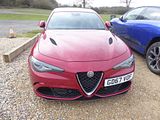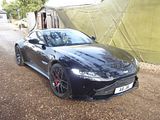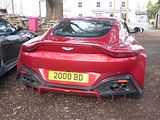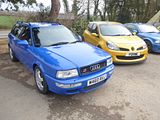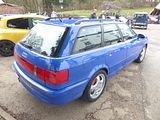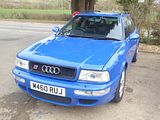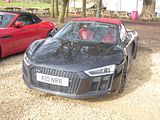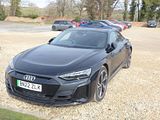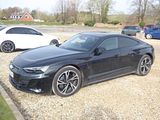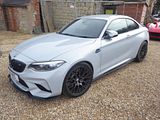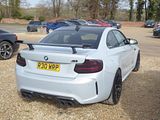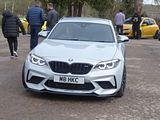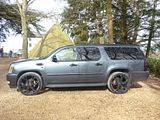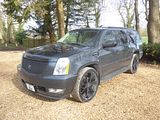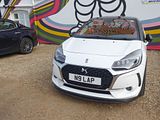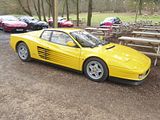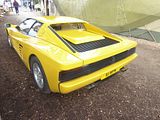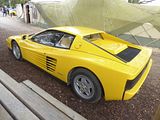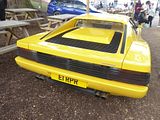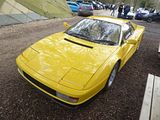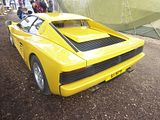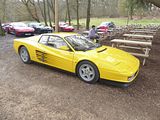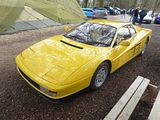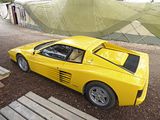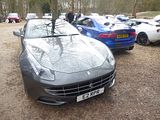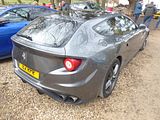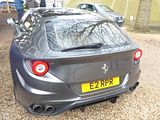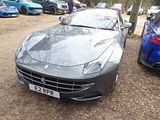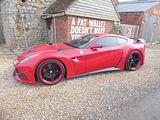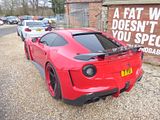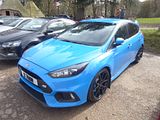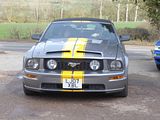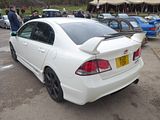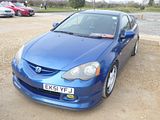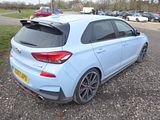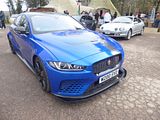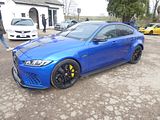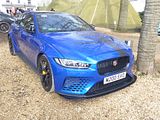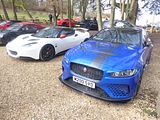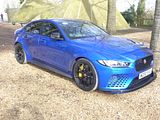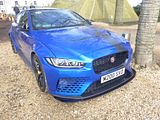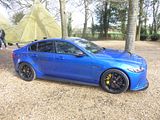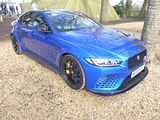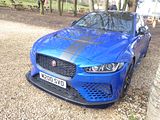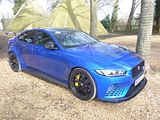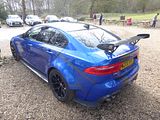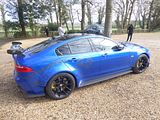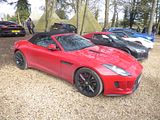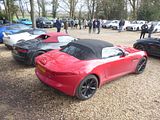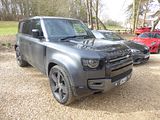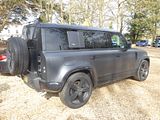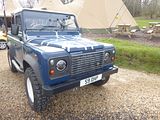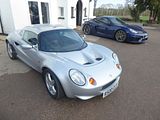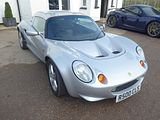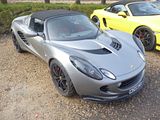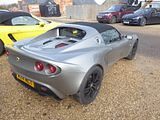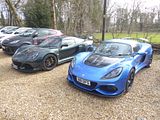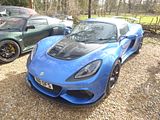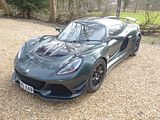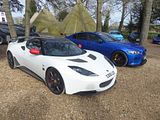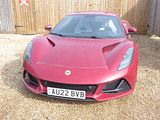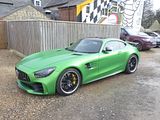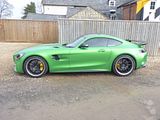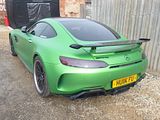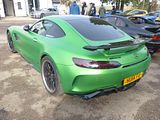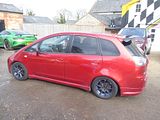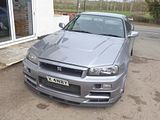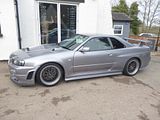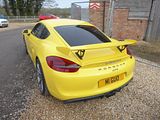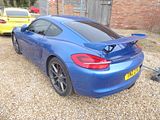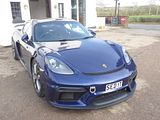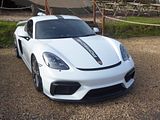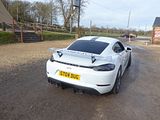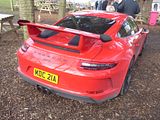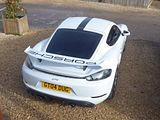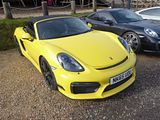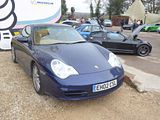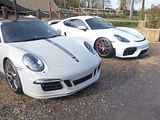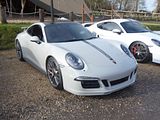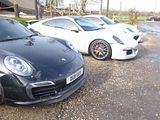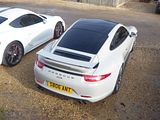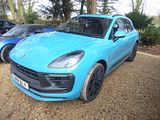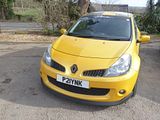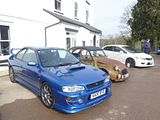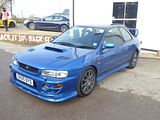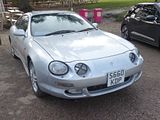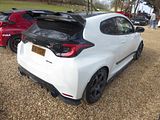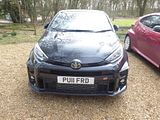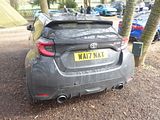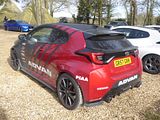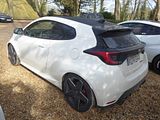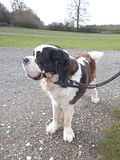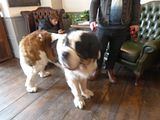Time for another visit to Caffeine & Machine, as once again, I had been staying in Coventry overnight on a Friday evening and had time in my schedule to call off at this popular Warwickshire location en route home. Tickets were still readily available at the last minute, which is not always a good sign, as this can means that things will be a bit quiet, but I need hardly worry as when I arrived, there were plenty of cars, and I was told that the whole area under the trees was reserved for a massive gathering in celebration of someone’s birthday. The chap in question clearly has a lot of car friends as this was soon filled up with everything from an array of Toyota Yaris GR (I believe the birthday boy himself has one) as well as a number of supercars. There was ample space elsewhere on site, even though the winter parking restrictions are still on force, for a lot of other and varied cars and that is exactly what I got during my time there.
Before getting to the cars, though, I have to confess to having made a discovery of the home-made treats that are displayed temptingly on the bar counter. Temptation was too much and I had to try one of the rocky road bars and it really was a good as it looks! And the indulgent coffee that went with was a special treat, too! Bot are in fact orderable on the menu that you pull up online, but I’d not gone for looking for these ideas in the past. Somehow, I just know that I will want them again!
And so onto the cars that were parked up or onsite during my visit.
ALFA ROMEO
In a day that was short on Italian cars at the venue, this current Giulia stood out even more than usual.
ASTON MARTIN
Following the unveiling of the AMV8 Vantage concept car in 2003 at the North American International Auto Show designed by Henrik Fisker, the production version, known as the V8 Vantage was introduced at the Geneva Motor Show in 2005. The two seat, two-door coupé had a bonded aluminium structure for strength and lightness. The 172.5 inch (4.38 m) long car featured a hatchback-style tailgate for practicality, with a large luggage shelf behind the seats. In addition to the coupé, a convertible, known as the V8 Vantage Roadster, was introduced later in that year. The V8 Vantage was initially powered by a 4.3 litre quad-cam 32-valve V8 which produced 380 bhp at 7,300 rpm and 409 Nm (302 lb/ft) at 5,000 rpm. However, models produced after 2008 had a 4.7-litre V8 with 420 bhp and 470 Nm (347 lbft) of torque. Though based loosely on Jaguar’s AJ-V8 engine architecture, this engine was unique to Aston Martin and featured race-style dry-sump lubrication, which enabled it to be mounted low in the chassis for an improved centre of gravity. The cylinder block and heads, crankshaft, connecting rods, pistons, camshafts, inlet and exhaust manifolds, lubrication system and engine management were all designed in house by Aston Martin and the engine was assembled by hand at the AM facility in Cologne, Germany, which also built the V12 engine for the DB9 and Vanquish. The engine was front mid-mounted with a rear-mounted transaxle, giving a 49/51 front/rear weight distribution. Slotted Brembo brakes were also standard. The original V8 Vantage could accelerate from 0 to 60 mph in 4.8 seconds before topping out at 175 mph. In 2008, Aston Martin introduced an aftermarket dealer approved upgrade package for power and handling of the 4.3-litre variants that maintained the warranty with the company. The power upgrade was called the V8 Vantage Power Upgrade, creating a more potent version of the Aston Martin 4.3-litre V8 engine with an increase in peak power of 20 bhp to 400 bhp while peak torque increased by 10 Nm to 420 Nm (310 lb/ft). This consists of the fitting of the following revised components; manifold assembly (painted Crackle Black), valved air box, right and left hand side vacuum hose assemblies, engine bay fuse box link lead (ECU to fuse box), throttle body to manifold gasket, intake manifold gasket, fuel injector to manifold seal and a manifold badge. The V8 Vantage had a retail price of GB£79,000, US$110,000, or €104,000 in 2006, Aston Martin planned to build up to 3,000 per year. Included was a 6-speed manual transmission and leather-upholstery for the seats, dash board, steering-wheel, and shift-knob. A new 6-speed sequential manual transmission, similar to those produced by Ferrari and Lamborghini, called Sportshift was introduced later as an option. An open-topped model was added to the range in 2006 and then in the quest for more power a V12 Vantage joined the range not long after. There were no fewer than 18 different versions of the Vantage produced during its production run.
The latest and still current Aston Martin Vantage was unveiled on 21 November 2017 with production starting in June 2018, replacing the previous model which had been in production for 12 years. It introduced a new styling direction but this was not universally well received and the car had a hefty price increase over its predecessor. Muted press enthusiasm did not help and sales have been disappointing. Aston Martin have continued to develop the model with a number of new versions introduced, to try to improve demand. The Vantage AMR is a track-focused variant of the Vantage. The main highlight of the model is the replacement of the ZF 8-speed automatic transmission with a dog-leg Graziano Trasmissioni 7-speed manual transmission previously used on the V12 Vantage S. The AMR also comes with a driver-selectable AMSHIFT system which controls the throttle during gear shifting. A new limited-slip differential ensures linear delivery of power. The power-band of the engine is wider and the unit is designed to deliver 625 N⋅m (461 lb⋅ft) of torque from 2,000 rpm to 5,000 rpm. The use of a manual transmission and carbon-ceramic brakes reduce the weight by 95 kg (209 lb). New adaptive dampers with the section of Sport, Sport + and Track modes improve handling. Performance figures include a 0–97 km/h (60 mph) acceleration time of 3.9 seconds, half a second more than the standard Vantage while the top speed remains the same as the standard model. Visual changes include 20-inch forged wheels as available on the Rapide AMR, new carbon fibre side vents and cooling vents present on the hood a sports exhaust system with quad tailpipes and racing bucket seats. Production of the AMR will be limited to 200 units worldwide. Available exterior colours for the AMR include Sabiro Blue, Pnyx Black, China Grey and White Stone. The final 59 cars will be finished in a Sterling Green exterior colour with Lime accents and will pay homage to the 1959 24 Hours of LeMans victory of Aston Martin. Once the production of the AMR ceases, the 7-speed manual transmission will become available on the standard Vantage. The vehicle went on sale in May 2019, with delivery set to begin in Q4 2019. Revealed in February 2020, the Vantage Roadster is a convertible version of the V8 Coupe with a fabric roof. The roof claimed to be the fastest of any automotive automatic convertible system, takes 6.7 seconds to lower and 6.8 seconds to raise and can be operated at speeds of up to 50 km/h (31 mph). The Vantage Roadster has a dry weight of 1,628 kg (3,589 lb). The F1 Edition is a version of the V8 Coupe and V8 Roadster commemorating Aston Martin’s return to Formula One after 61 years. The car features a fixed rear wing at the back, increased engine power to 535 PS (528 bhp), a top speed of 314 km/h (195 mph), new 21-inch wheel rims, and a 0–100 km/h (0–62 mph) acceleration time of 3.5 seconds. The car is available in three colours: Aston Martin Racing Green, Jet Black, and Lunar White. A convertible version called the Roadster is also available. Delivery began in May 2021.
AUDI
The Audi RS2 Avant, usually known as Audi 80 RS2, was a limited edition, high-performance Audi five-door, five-seat estate car manufactured from March 1994 to July 1995. Collaboratively designed as a joint venture between Audi AG and Porsche and built on Audi’s 80 Avant, designated internally as P1 (instead of B4/8C that it was based on). It was Audi’s first “RS” vehicle, and the first of their high-performance Avants. It was powered by a modified version of their 2,226 cc inline 5 DOHC 4 valves/cylinder 20 valves total turbocharged petrol engine. This produced 315 PS (311 bhp) @ 6,500 rpm and 410 Nm (302 lb/ft) @ 3000 rpm of torque. Although much of the car’s underpinnings were manufactured by Audi, assembly was handled by Porsche at their Rossle-Bau plant in Zuffenhausen, Germany, which had become available after discontinuation of the Mercedes-Benz 500E, which Porsche had manufactured there under contract. The Rossle-Bau plant also produced the famous Porsche 959. Like the rest of the vehicle, the RS2’s five-cylinder engine was based on a unit that Audi already produced, although Porsche considerably modified the engine; the standard KKK turbocharger was switched for a larger unit, along with a heavy-duty intercooler and higher flow fuel injectors, a newly designed camshaft, a more efficient induction system, and a low-pressure exhaust system replaced the standard fare; a specially modified URS4/URS6 Bosch-supplied engine management system (ECU) controlled the engine. With so much power available, the RS2 could accelerate from 0 to 100 km/h (62 mph) in 4.8 seconds, and achieve a maximum speed of 262 km/h (163 mph) (electronically restricted), despite weighing over 1,600 kg (3,500 lb). In a road test conducted in 1995, British car magazine Autocar timed the RS2 from 0 to 30 mph (48 km/h) at just 1.5 seconds, which they confirmed was faster than both the McLaren F1 road car, and also Jacques Villeneuve’s Formula One car of that time. Even by more modern standards, its performance is exceptional; it could accelerate on-par with the 5th generation Chevrolet Corvette (C5) and a 996 generation Porsche 911. The top speed was 166 mph (267 km/h). A six-speed manual gearbox was the only transmission choice. Audi’s Torsen-based ‘trademark’ quattro permanent four-wheel drive system was standard. Front and rear final drive units contained a conventional ‘open’ differential, and have a ratio of 4.111, although the rear also has an electro-mechanical diff lock. Porsche-designed braking and suspension systems replaced the standard Audi 80 equipment, however, the Bosch Anti-lock braking system (ABS) was retained. There were upgraded brakes, with large radially ventilated disc brakes, and Brembo four-opposed piston fixed calipers. 40 millimetres (1.6 in) lower than a standard 80 Avant, the suspension and braking upgrades combined to give the RS2 the handling and braking capabilities of a high-end sports car; 7.0Jx17 inch Porsche ‘Cup’ wheels, and high-performance 245/40 ZR17 Dunlop tyres were standard as well. In fact, the braking system wore Porsche-badged Brembo calipers, and both the wheels and side mirrors were identical in design to those of the 964 Turbo. Additionally, the word “PORSCHE” is inscribed in the RS2 emblem affixed to the rear tailgate and front grille. A three-spoke leather steering wheel, Recaro sports-bucket seats (available in full leather or a leather/suede combination), and console materials in either wood or carbon fibre trim rounded out the vehicle’s interior changes. Audi’s proprietary Safety Restraint System, procon-ten remained from its donor vehicle. Approximately 2200 RS2s were to be built initially, but due to demand the total was 2891 cars built. Of these, only 180 were right hand drive cars built for the UK, New Zealand and South African markets.
This is the second generation R8. Launched at the 2015 Geneva Motor Show and is based on the Modular Sports System platform shared with the Lamborghini Huracan. The development of the Type 4S commenced in late 2013 and was completed in late 2014. Initial models included the all-electric e-Tron and the V10 5.2 FSI along with the V10 plus. Unlike its predecessor, there was no manual transmission available and the entry-level V8 trim was also dropped. In 2016, the convertible (Spyder) variant was added to the line up which was initially available in the base V10 trim. In mid-2017, the high performance V10 plus Spyder was added to the range. A rear-wheel-drive model called the R8 RWS was introduced. In 2018, the R8 received a mid-cycle refresh with mechanical and exterior changes. The newer and more aggressive design language carried over from famous Audi models of the past and its appearance is slightly more angular up front. Some of the aerodynamic features such as the front aeroblades are shared with the Lamborghini Huracàn. The refreshed model had substantial performance improvements over its predecessor. The base R8 got a power boost from 532 hp to 562 hp, while the V10 Plus was renamed V10 Performance Quattro and the engine saw a power increase by 10 hp, now up to 612 hp. It remains a current model.
Representing the future for the fast Audi, perhaps, was this eTron GT, an all-electric sports saloon that shares much underneath with the Porsche Taycan.
BMW
The M2 was first revealed in Need for Speed: No Limits on November 2015, before later premiering at the North American International Auto Show in January 2016. Production commenced in October 2015 and is only available as a rear-wheel drive coupé. The M2 is powered by the turbocharged 3.0-litre N55B30T0 straight-six engine producing 365 bhp at 6,500 rpm and 465 Nm (343 lb/ft) between 1,450–4,750 rpm, while an overboost function temporarily increases torque to 500 N⋅m (369 lb⋅ft). The M2 features pistons from the F80 M3 and F82 M4, and has lighter aluminium front and rear suspension components resulting in a 5 kg (11 lb) weight reduction. The M2 is available with a 6-speed manual or with a 7-speed dual-clutch transmission which features a ‘Smokey Burnout’ mode. 0-100 km/h acceleration times are 4.5 seconds manual transmission models and 4.3 seconds for models equipped with the 7-speed dual clutch transmission. Top speed is limited to 250 km/h (155 mph) but can be extended to 270 km/h (168 mph) with the optional M Driver’s package. The M2 Competition was introduced at the 2018 Beijing Auto Show and succeeded the standard M2 Coupé. Production began in July 2018. The M2 Competition uses the high performance S55 engine which is a variant of the 3.0-litre twin turbocharged straight six engine found in the F80 M3 and F82 M4. The engine features a redesigned oil supply system and modified cooling system from the BMW M4 with the Competition Package, and also features a gasoline particulate filter in certain European Union countries to reduce emissions. Compared to the standard M2, the S55 produces an additional 40 bhp and 85 Nm (63 lb/ft), resulting in a larger and more sustained power output of 405 bhp between 5,370–7,200 rpm, and 550 Nm (406 lb/ft) at 2,350–5,230 rpm. The 0-100 km/h acceleration time is 4.4 seconds for six-speed manual transmission models, and 4.2 seconds for models with the 7-speed dual clutch transmission. Top speed is electronically limited to 250 km/h (155 mph), but the M Driver’s package can extend the limit to 280 km/h (174 mph) which is 10 km/h (6 mph) further than in the M2. The M2 Competition also has a carbon-fibre reinforced plastic strut bar, enlarged kidney grilles, and larger brake discs of 400 mm (15.7 in) in the front axle and 380 mm (15.0 in) in the rear axle. Because of the new engine and cooling system, the M2 Competition is 55 kg (121 lb) heavier than the standard M2 at 1,550 kg (3,417 lb) for manual transmission models and 1,575 kg (3,472 lb) for dual-clutch transmission models. Production ceased in late 2022 pending the arrival of the next generation car.
There were plenty of other BMW models here, a lot of them being M cars and these M3 and M5 models were the ones that stood out for my camera.
CADILLAC
The Cadillac Escalade is a full-size luxury SUV engineered and manufactured by General Motors. It was Cadillac’s first major entry into the SUV market. The Escalade was introduced for the 1999 model year in response to an influx of new luxury SUVs in the late 1990s such as the Mercedes-Benz M-Class, Range Rover, Lexus LX, and (especially) Ford’s 1998 debut of the Lincoln Navigator. The Escalade project went into production only ten months after it was approved. The Escalade is built in Arlington, Texas. The term “escalade” refers to a siege warfare tactic of scaling defensive walls or ramparts with the aid of ladders or siege towers. More generally, it is a French word which is the noun-equivalent form of the French verb escalader, which means “to climb or scale”. Unlike its Chevrolet and GMC siblings, which launched for the 2000 model year, Cadillac delayed the Escalade’s switch to the GMT820 chassis until February 2001 as a 2002 model, the last of the three General Motors full-size truck and SUV brands to switch to the new chassis; Cadillac unveiled the 2002 model year Escalade in August 2000 at Pebble Beach, while continuing to sell the 2000 model year trucks. Rear-wheel drive was standard, as was a 5.3 L V8. All-wheel drive was standard on the ESV (until 2008 for the third generation) and EXT and was optional on the short wheelbase Escalade. The special high-output Vortec 6.0 L V8 engine was the sole engine choice on all-wheel drive models whether it was the short wheelbase, ESV, or EXT until mid-year 2005 when the 5.3L was dropped altogether. Mid-year 2005, all rear-wheel drive and all-wheel drive Escalades came with the high output 6.0L Vortec V8. All models (except for the EXT) offered seating up to eight passengers. The “StabiliTrak” electronic stability control system was upgraded to a four-wheel version, High Intensity Discharge (HID) low beam headlights, power-adjustable pedals and signal outside mirrors were added as a standard feature in 2003, along with a Bulgari-branded clock.[10] For 2004, XM Satellite Radio, second-row bucket seats, and a tire pressure monitoring system were made standard on all Escalades except the EXT. Also in 2004, the Platinum edition Escalade ESV was introduced at a base price of $71,025; it featured the luxury utility segment’s first factory-installed 20-inch chrome wheels, a slightly lowered suspension, heated and cooled seats (front and back), heated and cooled cup holders, moon roof, second and third row monitors, an interior that included an ebony and shale dashboard, shale leather upholstery and pleated door panel bolsters, a chrome grille, and a standard 6.0 liter V8 producing 345 bhp. The OnStar system was upgraded for the 2005 model year and had become a digital system instead of the analog system that had been in use. In 2003, a year after their introduction, the GMT800-based Cadillac Escalade and Escalade EXT received an interior facelift, while the exterior design was left mostly unchanged. The audio system was upgraded to offer two different radio options: an AM/FM radio with cassette and single-disc CD players, or an AM/FM radio with a single-disc CD player and a touchscreen GPS navigation system (Radio Data System (RDS) was also included with both radios). Both radio options included a separate six-disc, in-dash CD changer unit mounted in the lower portion of the instrument panel and controlled via the radio (the CD changer still featured numbered buttons for disc selection, as well as ‘Load’ and ‘Eject’ buttons). The Driver Information Center (DIC) was moved from a separate unit in the instrument panel to the odometer display screen in the instrument cluster, where the gauges were also revised with the larger odometer display screen. XM Satellite Radio became available, and the OnStar telematics system controls were relocated from the instrument panel to the electrochromic inside rearview mirror (ISRV). A rear seat DVD entertainment system, which included two pairs of wireless headphones, and was produced by Panasonic, was also a new option for the 2003 model year. The instrument panel and steering wheel both featured updated designs (the steering wheel now also featured remote audio system, OnStar, and speed (cruise control) buttons on the front of the wheel). The electrochromic inside rearview mirror (ISRV) now integrated the OnStar system controls in addition to the exterior (outside) temperature display and integrated directional compass. The front and second and third-row seat designs were updated, and the Zebrano interior trim was replaced with Burlwood. The Escalade ESV (extended-length model) debuted for the 2003 model year. Finally, the warning chimes now played through the front driver’s door speaker, as opposed to a separately mounted chime module on 2002 models.
DS
Now in that phase when numbers are starting to reduce, but not enough to make the car rare, is the DS3, the first model in Citroen’s spin-off brand.
FERRARI
A replacement for the BB512i, the final iteration of Ferrari’s first ever mid-engined road car, the Testarossa was launched at the Paris Show in October 1984. The Pininfarina-designed car was produced until 1991, with the same basic design then going through two model revisions, with the 512 TR and later F512 M which were produced from 1992 to 1996 before the model was replaced by the front-engined 550 Maranello. Almost 10,000 Testarossas, 512 TRs, and F512 Ms were produced, making it one of the most-produced Ferrari models, despite its high price and exotic design. The Testarossa followed the same concept as the BB512, but was intended to fix some of the criticisms of the earlier car, such as a cabin that got increasingly hot from the indoor plumbing that ran between the front-mounted radiator and the midships-mounted engine and a lack of luggage space. This resulted in a car that was larger, and at 1,976 millimetres (78 in) wide the Testarossa was half a foot wider than the Boxer and immediately condemned for being too wide, though these days it does not appear anything like as wide as it did when new. This resulted in an increased wheelbase that stretched about 64 mm (2.5 in) to 2,550 mm (100 in) which was used to accommodate luggage in a carpeted storage space under the front forward-opening lid. The increase in length created extra storage space behind the seats in the cabin. Headroom was also increased with a roofline half an inch taller than the Boxer. The design came from Pininfarina with a team of designers led by design chief Leonardo Fioravanti, the designer of many contemporary Ferraris. The design was originated by Nicosia, but the guidance of Fioravanti was equally important. Being a trained aerodynamicist, Fioravanti applied his know-how to set the aerodynamics layout of the car. This meant the large side intakes were not only a statement of style but actually functional – they drew clean air to cool the side radiators and then went upward and left the car through the ventilation holes located at the engine lid and the tail. As a result, the Testarossa did not need a rear spoiler like Lamborghini’s Countach yet produced zero lift at its rear axle. The aerodynamic drag coefficient of 0.36 was also significantly better than the Lamborghini’s 0.42. Pininfarina’s body was a departure from the curvaceous boxer—one which caused some controversy. The side strakes sometimes referred to as “cheese graters” or “egg slicers,” that spanned from the doors to the rear wings were needed for rules in several countries outlawing large openings on cars. The Testarossa had twin radiators in the back with the engine instead of a single radiator up-front. In conjunction the strakes provided cool air to the rear-mounted side radiators, thus keeping the engine from overheating. The strakes also made the Testarossa wider at the rear than in the front, thus increasing stability and handling. One last unique addition to the new design was a single high mounted rear view mirror on the driver’s side. On US based cars, the mirror was lowered to a more normal placement in 1987 and quickly joined by a passenger side rear view mirror for the driver to be able to make safe easy lane changes. Like its predecessor, the Testarossa used double wishbone front and rear suspension systems. Ferrari improved traction by adding 10-inch-wide alloy rear wheels. The Testarossa drivetrain was also an evolution of the BB 512i. Its engine used near identical displacement and compression ratio, but unlike the BB 512i had four-valve cylinder heads that were finished in red. The capacity was 4,943 cc, in a flat-12 engine mid mounted. Each cylinder had four valves, lubricated via a dry sump system, and a compression ratio of 9.20:1. These combined to provide a maximum torque of 490 Nm (361 lb/ft) at 4500 rpm and a maximum power of 390 hp at 6300 rpm. That was enough to allow the Testarossa to accelerate from 0–60 mph in 5.2 seconds and on to 100 mph. The original Testarossa was re-engineered for 1992 and released as the 512 TR, at the Los Angeles Auto Show, effectively as a completely new car, with an improved weight distribution of 41% front: 59% rear. The F512 M was introduced at the 1994 Paris Auto Show, with the M standing for “modificata”. That car is easy to spot as it lost the pop-up headlights and gained awkward glazed in units.
The Ferrari FF (FF meaning “Ferrari Four”, for four seats and four-wheel drive, the Type F151) is a grand tourer presented by Ferrari on March 1, 2011 at the Geneva Motor Show as a successor to the 612 Scaglietti and is Ferrari’s first production four-wheel drive model. The body style has been described as a shooting-brake, a type of sporting hatchback/estate car with two doors. With a top speed of f 335 km/h (208 mph) and it accelerates from 0 to 100 km/h (62 mph) in 3.7 seconds, Ferrari stated that the FF was the world’s fastest four-seat automobile upon its release to the public. At the time of its reveal, the Ferrari FF had the largest road-going Ferrari engine ever produced: an F140 EB 6,262 cc naturally aspirated direct injected 65° V12, which produced 660 PS (485 kW; 651 hp) at 8,000 rpm and 683 N⋅m (504 lb⋅ft) of torque at 6000 rpm. The FF is equipped with a 7-speed dual-clutch transmission and paddle shift system similar to the California, the 458 Italia, and the Ferrari F12berlinetta. The new four-wheel drive system, engineered and patented by Ferrari, is called 4RM: it is around 50% lighter than a conventional system, and provides power intelligently to each of the four wheels as needed. It functions only when the manettino dial on the steering wheel is in the “comfort” or “snow” positions, leaving the car most often in the traditional rear wheel drive layout. Ferrari’s first use of 4RM was in a prototype created in the end of the 80s, called 408 4RM (abbreviation of “4.0 litre, 8 cylinder, 4 Ruote Motrici”, meaning “four-wheel drive”). This system is based around a second, simple, gearbox (gears and other components built by Carraro Engineering), taking power from the front of the engine. This gearbox (designated “power take off unit”, or PTU) has only two forward gears (2nd and 4th) plus reverse (with gear ratios 6% taller than the corresponding ratios in the main gearbox), so the system is only active in 1st to 4th gears. The connection between this gearbox and each front wheel is via independent Haldex-type clutches, without a differential. Due to the difference in ratios “the clutches continually slip” and only transmit, at most, 20% of the engine’s torque. A detailed description of the system (based on a conversation with Roberto Fedeli, Ferrari’s technical director) has been published. The FF shares the design language of contemporary Ferraris, including the pulled-back headlights of the 458 Italia, and the twin circular taillights seen on the 458 as well as the 599 GTB Fiorano. Designed under the direction of Lowie Vermeersch, former Design Director at Pininfarina, and Flavio Manzoni, Ferrari’s Styling Centre, work on the shooting brake concept initially started following the creation of the Sintesi show car of 2007. Distinctive styling elements include a large egg-crate grille, defined side skirts, and four exhaust tips. The shooting brake configuration is a departure from the conventional wedge shape of modern Ferraris, and the FF has been likened to the similarly-shaped 1962 Ferrari 250 GT SWB Drogo race car. The combination of hatchback-like shooting-brake design and collapsible rear seats gives the Ferrari FF a boot capacity of between 16 and 28 cu ft. Luxury is the main element of the interior and the use of Leather is incorporated throughout, just like the predecessors of the FF. Creature comforts like premium air conditioning, GPS navigation system, carpeting and sound system are also used. An updated version. called the GTC4 Lusso was launched in 2016 by which 2291 examples had been built.
Launched at the 2015 Geneva Show, the 488GTB followed the lead set by the California T in bringing turbocharging into a modern-day, mid-engined V8 Ferrari supercar for the first time. The engine is completely new when compared with its V8 stablemate, not only in components but also in feel and character. It is a twin-turbocharged 3902cc unit whilst that in the California T is 3855cc. In the 488 GTB, it produces 660bhp at 8000rpm and 560lb ft at 3000rpm. Both outputs are significant increases over the normally aspirated 4.5-litre V8 used in the 562 bhp 458 Italia and 597 bhp 458 Speciale, and also greater than the car’s biggest rival, the McLaren 650S. The torque figure of the 488 GTB is such that it also exceeds the 509lb ft at 6000rpm of the normally aspirated V12 used in the range-topping Ferrari F12 Berlinetta. The mighty new engine in the 488 GTB drives the rear wheels through a revised seven-speed dual-clutch automatic gearbox derived from the 458. It features a new ‘Variable Torque Management’ system which, Ferrari says, “unleashes the engine’s massive torque smoothly and powerfully right across the rev range”. The gear ratios are also tuned to “deliver incredibly progressive acceleration when the driver floors the throttle”. The 488 GTB can crack 0-62mph in just 3.0sec, 0-124mph in 8.4sec and reach a top speed of 205mph. Its 0-62mph and 0-124mph times match the McLaren 650S’s, but the Woking car’s top speed is slightly higher at 207mph. The engine also accounts for the ‘488’ element of the car’s name, because each of the engine’s eight cylinders is 488cc in capacity when rounded up. The GTB suffix, standing for Gran Turismo Berlinetta, is a hallmark of previous mid-engined V8 Ferraris such as the 308 GTB. Not only is the new turbo engine more potent than the 4.5-litre V8 from the 458 Italia, but it is also more economical. Combined fuel economy is rated at 24.8mpg, compared with 21.2mpg in the 458 Italia, and CO2 emissions are 260g/km – a 47g/km improvement. Ferrari’s HELE engine stop-start system features on the 488 GTB. Developments on the dynamic side include a second generation of the Side Slip Angle Control system, called SSC2. This allows the driver to oversteer without intruding, unless it detects a loss of control. The SSC2 now controls the active dampers, in addition to the F1-Trac traction control system and E-Diff electronic differential. Ferrari says the result is “more precise and less invasive, providing greater longitudinal acceleration out of corners” and flatter, more stable behaviour during “complex manoeuvres”. Learnings from the Ferrari XX programme have also been incorporated into the 488 GTB, something that Ferrari says allows all drivers and not just professionals, to make the most of its electronic and vehicle control systems. It also claims the 488 GTB is “the most responsive production model there is”, with responses comparable to a track car. The 488 GTB has lapped Ferrari’s Fiorano test track in 1min 23sec – two seconds faster than the 458 Italia, and half a second quicker than the 458 Speciale. The dimensions of the 488 GTB – it is 4568mm in length, 1952mm in width and 1213mm in height – closely match the 458 Italia from which it has evolved. Its dry weight is 1370kg when equipped with lightweight options – 40kg more than the McLaren 650S. The new look, styled at the Ferrari Styling Centre, features several new aerodynamic features that improve downforce and reduce drag. Most notable is the addition of active aerodynamics at the rear through a ‘blown’ rear spoiler, where air is channelled from the base of the glass engine cover under the spoiler. This contributes to the 50% increase in downforce over the 458 Italia. Also new is a double front spoiler, an aerodynamic underbody, a large air intake at the front that references the 308 GTB, a diffuser with active flaps, new positioning for the exhaust flaps and new-look lights. The interior has been redesigned to be made more usable, including new switchgear, air vents and instrument panel. The multi-function steering wheel remains, while the infotainment system gets a new interface and graphics. The Spider followed the closed coupe model six months later. This became the bigger seller of the pair, as was the case with the 458 models.
The Ferrari F12berlinetta (Type F152) is a front mid-engine, rear-wheel-drive grand tourer which debuted at the 2012 Geneva Motor Show, and replaces the 599 grand tourer. The naturally aspirated 6.3 litre Ferrari V12 engine used in the F12berlinetta has won the 2013 International Engine of the Year Award in the Best Performance category and Best Engine above 4.0 litres. The F12berlinetta was named “The Supercar of the Year 2012” by car magazine Top Gear. The F12berlinetta was replaced by the 812 Superfast in 2017.
FORD
Ford played much the same guessing game about whether there would be an RS version of the third generation Focus as they had done with the earlier versions. Production of the regular cars started in late 2010, but it was not until the 2015 Geneva Motor Show before the production ready MKIII Ford Focus RS was unveiled. It came packing the turbocharged 2.3-litre inline-four engine found in the Mustang EcoBoost. In the Focus RS, the engine itself produces 350 hp. Power is sent to all four wheels via Ford’s all-new Torque-Vectoring All-Wheel-Drive system with a rear drive unit designed by GKN, as well as upgraded suspension and brakes. As well as that, the new Focus RS will be fitted with Drive Modes – including an industry-first Drift Mode that allows controlled oversteer drifts – and Launch Control. The RS will boast a model specific aerodynamic package that helps to differentiate it from other Focus models. The RS is capable of accelerating to 100 km/h (62 mph) in 4.7 seconds. Sales finally started in mid 2016, with long waiting lists having been created, though Ford did eventually catch up with expanded production levels allowing them to meet the demand.
The 2004 Mustang, with is styling that harked back to the much-loved 1964 original proved to be quite a hit, renewing interest in the model and encouraging arch rivals Chevrolet an Dodge to produce retro-inspired rivals. Whilst the car was not officially imported to the UK, quite a number of them have found their way here and this was one of them.
HONDA
The Japanese market Civic Type R (FD2) went on sale on 30 March 2007. For the first time, the JDM Civic Type R was sold as a four-door sedan, rather than a three-door hatchback. The FD2 Type R was bigger, wider and heavier than the EP3 Type R. The wheelbase grew from 2,570 mm (101.2 in) to 2,700 mm (106.3 in), giving the FD2 more stability during high speed cornering. The Japanese model’s engine power output is higher than the European versions, with 225 PS being generated at 8,000 rpm and 215 Nm (159 lb/ft) of torque peaking at 6,100 rpm (versus 201 PS) at 7,800 rpm and 193 Nm (142 lb/ft) at 5,600 rpm for the European model). Honda quoted that mid-range is increased by 10 PS. Power is sent to the front wheels through a close-ratio six-speed manual transmission, and a helical limited-slip differential is fitted as standard. The front brake discs are 320 mm (12.6 in) diameter and fitted with four-piston Brembo calipers. The car is fitted with Bridgestone Potenza RE070 tyres having a size of 225/40 R18. Honda claims the chassis is 50% more rigid than the previous Japan-only pre-facelift DC5 Integra Type R and 25% more rigid than the previous Japan-only facelift DC5 Integra Type R. The FD2 features an independent rear suspension rather than the torsion beam configuration used on the FN2 Type-R. To save weight, aluminium is used extensively and bonded with adhesive instead of welded. Though the chassis is larger and more rigid than the JDM Integra Type R, it is only 70 kg (154 lb) heavier. Exterior wise, the front bumper is wider and different from the standard Civic designed aerodynamically. The rear bumper features a diffuser built into the bumper and a large rear wing completes the aero package. Inside, the trademark black and red bucket seats are no longer made by Recaro as with previous versions but designed in-house by Honda. Also gone is the Momo made steering wheel, instead replaced by a Honda made version. The familiar red-on-black colour scheme or black-on-black scheme is offered on Championship White and Super Platinum Metallic Silver while a black-on-black scheme with red stitching is for the Vivid Blue Pearl model only. In October 2008, the Type R received new colours, those being Premium White Pearl, Premium Deep Violet Pearl and Crystal Black Pearl. The Vivid Blue Pearl colour was dropped. In back to back tests, the Civic Type R (FD2) was on average 1 second quicker than the Integra Type-R (DC5) at the Tsukuba Circuit and four seconds faster at the longer Suzuka Circuit. In a back-to-back test on the United Kingdom TV program Fifth Gear, the FD2 Type-R was three seconds quicker than the equivalent FN2 UK version around Castle Combe Circuit in wet conditions. However, the FN2 managed a 13.1 second quarter mile pass at Killarney Raceway. A total of 14,062 FD2 Civic Type R units were produced until it ceased production in August 2010 due to failure to meet the upcoming emission requirements. Following the previous success due to the introduction of the FN2 Civic Type R from Europe in 2009, another batch of FN2 Type R with minor updates was available in Japan from fall 2010. However, the engine was the same K20Z4 straight-4 as used in the European version. A number of these cars have come to the UK as Grey Market imports.
This is an Integra type R and is from the fourth and final generation of the car, often referred to as the DC5, which is the Honda internal reference fro the car. The fourth generation Integra was introduced in Japan on April 13, 2001 and produced from July 2001 to July 2006. For North America (United States and Canada), it was introduced as the Acura RSX in accordance with Acura’s new alphabetical naming scheme. It also had an entirely new engine, the K-series. The Integra came in two models in the United States, the RSX and the RSX Type-S boasting the K20A2 engine from 2002 to 2004, while the 2005 and 2006 RSX-S came with a K20Z1. The RSX was sold as a Honda Integra in Japan and Australia, markets where Acura did not exist. In March 2006, Honda announced that the Integra would be discontinued in June after its final 300 cars were sold, due to the shrinkage of the coupe market. The reaction of the consumers towards the discontinuation, however, forced Honda to extend production until July 2006 and produce 150 more Integras. The Acura RSX was discontinued as well, as the RSX did not fit within the confines of Acura’s re-structured market strategy. This left the Acura TSX as Acura’s entry-level vehicle. Also, the introduction of the similarly powerful and less expensive 2006 model-year Honda Civic Si was there to fill in the gap left by the RSX. The DC5 Type R (Japanese market only) comes standard with a K20A 220 hp 2.0 litre DOHC i-VTEC four-cylinder engine. The “i” in i-VTEC stands for intelligent VTEC, which employs VTC (Variable Timing Control) to advance or retard the intake cam timing within a 50 degree range. The Integra Type R comes equipped with Recaro seats, four-piston Brembo front brakes, a close ratio six-speed manual transmission, a limited-slip differential, variable back-pressure exhaust system, and a stiffer suspension.
HYUNDAI
Another car which was usually represented here is the i30N, the first of a growing series of N-badged sporting models from the Korena giant. This was launched in 2017 and has proved popular ever since.
JAGUAR
This is a Jaguar XE SV Project Eight. This limited-run super-saloon (of sorts) was unveiled in 2017, with the first cars hitting the roads in the middle of 2019. Just 300 are set to be built. It was developed — and is being built by — Jaguar Land Rover’s Special Vehicle Operations, the division that’s responsible for high-performance SVR-branded Range Rovers and F-Types, as well as low-volume specials such as the 2015 F-Type Project 7. The Project 8 is only available with left-hand drive. It shares its basic body-in-white with the everyday XE, but just about everything else is new. Every body panel but the roof and front doors are bespoke, the suspension has been entirely reworked and Michelin Pilot Sport Cup 2 tyres feature on a Jaguar for the very first time. The familiar 5.0-litre supercharged V8 that serves across JLR has also been shoehorned in. Here, it develops 592bhp and 516lb ft, making the Project 8 Jaguar’s most powerful road car to date. The aero package is bespoke, too, of course, and capable of generating 122kg of downforce at 186mph. The optional Track Pack, which costs £10,000 and saves 12kg, swaps out the rear seats for a half-roll-cage and adds carbon-backed bucket seats up front with four-point harnesses. The price tag of £149,00 means that you have to be absolutely sure you want one, and it would seem that not enough people have been, with sales proving harder to find than Jaguar had anticipated.
Rather more affordable (it’s a relative term!) was this F Type, Jaguar’s latest and still-current sports car.
LAND ROVER
As well as the latest Defender, seen here in the rare V8 guise, thee was an example of the previous and long-lived model that has become really quite collectible.
LOTUS
It is now over 20 years since Lotus launched the Elise, a model which showed a return to the core values of simplicity and light-weight which were cornerstones of Colin Chapman’s philosophy when he founded the marque in 1955. The first generation Elise was produced for just over 4 years, with a replacement model, the Series 2 arriving in October 2000. It came about as the Series 1 could not be produced beyond the 2000 model production year due to new European crash sustainability regulations. Lacking the funding to produce a replacement, Lotus needed a development partner to take a share of investment required for the new car. General Motors offered to fund the project, in return for a badged and GM-engined version of the car for their European brands, Opel and Vauxhall. The result was therefore two cars, which although looking quite different, shared much under the skin: a Series 2 Elise and the Vauxhall VX220 and Opel Speedster duo. The Series 2 Elise was a redesigned Series 1 using a slightly modified version of the Series 1 chassis to meet the new regulations, and the same K-series engine with a brand new Lotus-developed ECU. The design of the body paid homage to the earlier M250 concept, and was the first Lotus to be designed by computer. Both the Series 2 Elise and the Opel Speedster/Vauxhall VX220 were built on the same production line, in a new facility at Hethel. Both cars shared many parts, including the chassis, although they had different drive-trains and power-plants. The VX220 carried the Lotus internal model identification Lotus 116, with the code name Skipton for the launch 2.2 normally aspirated version and Tornado for the 2 litre Turbo which came out in 2004. Fitted with 17 inch over the Elise’s 16 inch front wheels, the Vauxhall/Opel version ceased production in late 2005 and was replaced by the Opel GT for February 2007, with no RHD version for the United Kingdom. The Elise lived on. and indeed is still in production now, some 15 years later, though there have been countless different versions produced in that time. Whilst the first of the Series 2 cars came with the Rover K-Series engine, and that included the 111S model which had the VVC engine technology producing 160 hp , a change came about in 2005 when Lotus started to use Toyota engines. This was initially due to Lotus’ plans to introduce the Elise to the US market, meaning that an engine was needed which would comply with US emissions regulations. The selected 1.8 litre (and later 1.6 litre) Toyota units did, and the K-series did not. that MG-Rover went out of business in 2005 and engine production ceased confirmed the need for the change. Since then, Lotus have offered us track focused Elise models like the 135R and Sport 190, with 135 bhp and 192 bhp respectively, as well as the 111R, the Sport Racer, the Elise S and Elise R. In 2008 an even more potent SC model, with 218 bhp thanks to a non-intercooled supercharger was added to the range. In February 2010, Lotus unveiled a facelifted version of the second generation Elise. The new headlights are now single units; triangular in shape they are somewhat larger than the earlier lights. The cheapest version in Europe now has a 1.6 litre engine to comply with Euro 5 emissions, with the same power output as the earlier 1.8 136bhp car. Lotus has been through some difficult times in recent years, but things are looking more optimistic again, with production numbers having risen significantly in the last couple of years, after a period when next to no cars were made. The Elise production finally ceased at the end of 2021.
At the Frankfurt 2011 Show, the 2012 version of the Exige S was announced. It features a supercharged 3.5 litre V6 engine (from the Evora S) rated at 345 hp. In 2013, a roadster version was introduced with only minor changes to the design for the removable top. The engine and performance were virtually unchanged from the coupe. To accommodate the V6 engine, the new model is approximately 25 cm (9.8 inches) longer and 5 cm (2.0 in) wider (exterior bodywise) than the model with the inline-four engine, being 4,052 mm (159.5 inches) long, 1,802 mm (70.9 in) wide (not counting the mirrors) and 1,153 mm (45.4 in) tall. The drag coefficient is 0.433. Since that time there have been a bewildering array of different versions and you need to be a real marque expert to tell them all apart. The policy has worked, though, as sales have remained steady whilst Lotus try to amass the finances to develop any all new models. The Exige V6 Cup is a track oriented version of the Exige S while the Exige CupR is the track-only version of Exige V6 Cup. The Exige V6 Cup is offered for sale in the United States as a track only car. If purchased, US Lotus Dealers will only provide a bill of sale instead of a title. The vehicles were unveiled at the 2013 Autosport International motor show. Limited to 50 examples, the Lotus Exige 360 Cup was revealed on 14 August 2015. The car is powered by a 3.5-liter supercharged Toyota V6 delivering 355 hp. The Lotus Exige Sport 380 is a track focused and more powerful version of the Lotus Exige lineup. It was unveiled on 23 November 2016. Lotus’ CEO, Jean-Marc Gales describes it as, “The Exige Sport 380 is so good, that it is no longer the best in class, it’s now in a class of its own”, and it fulfills this statement by taking on some of the powerful and expensive super cars both on the track and the streets. The 3.5-litre, super-charged V6 engine is now uprated and produces 375 hp and 410 Nm (302 lb/ft) of torque with a 6500 rpm red line achieved by revised supercharger and ECU. It can accelerate from 0 to 60 mph in 3.5 seconds and has a top speed of 178 mph (286 km/h). The interior is also stripped out and features necessary driver aids. The Exige Sport 380 weighs 1,076 kg (2,372 lb), thanks to the extensive use of carbon fibre on the exterior as well as the interior, the application of polycarbonate windows instead of traditional glass windows and a newly designed rear transom panel which features two rear lights instead of four.The Lotus Exige Cup 380 is a more hardcore variant of the Exige Sport 380. Performance of the car remains the same as the Sport 380 but it features more aero components and a larger rear wing to produce more downforce at high speeds. The Exige Cup 380 generates 200 kg (441 lb) of downforce at its maximum speed of 175 mph (282 km/h); the top speed is reduced due to excess downforce and more drag. It features a more stripped out interior in order to save weight and other light weight carbon fiber components, Lotus states a lowest possible dry weight of only 1,057 kg (2,330 lb). On 9 November 2017, Lotus unveiled the most powerful version of the Exige to date called the Exige Cup 430, producing 430 PS (424 hp) and using the Evora GT430’s powertrain, modified to fit in the smaller Exige. The car body can produce 220 kg (485 lb) of downforce. The Cup 430 is 19 kg (42 lb) lighter than the Sport 380 due to the use of carbon fibre in body panels and interior and a titanium exhaust. The gearbox allows quicker gearshifts than the previous model. The Cup 430 is not offered with an automatic gearbox. The Lotus Exige Cup 430 is capable of covering the Hethel circuit in 1 minute 24.8 seconds – the fastest production car to lap the circuit – 1.2 seconds faster than the road going Lotus 3-Eleven.
Developed under the project name Project Eagle, this car was launched as the Evora on 22 July 2008 at the British International Motor Show. The Evora is based on the first all-new vehicle platform from Lotus Cars since the introduction of the Lotus Elise in 1995 (the Exige, introduced in 2000, and the 2006 Europa S are both derivatives of the Elise. Evora was planned to be the first vehicle of three to be built on the same platform and was the first product of a five-year plan started in 2006 to expand the Lotus line-up beyond its track-specialised offerings, with the aim of making Evora a somewhat of a more practical road car that would appeal to the mainstream. As such it is a larger car than recent Lotus models Elise and its derivatives (Exige, Europa S, etc.), with an unladen weight of 1,383 kg (3,049 lb). It is currently the only Lotus model with a 2+2 configuration, although it is also offered in a two-seater configuration, referred to as the “Plus Zero” option. It is also the only 2+2 mid engined coupé on sale. The interior is larger to allow taller persons of 6’5″ to fit. The cooled boot behind the engine is large enough to fit a set of golf clubs, although Lotus Design Head Russell Carr denies that this was intentional. Lotus intends Evora to compete with different market sectors including the Porsche Cayman. The name “Evora” keeps the Lotus tradition of beginning model names with an “E”. The name is derived from the words evolution, vogue, and aura. and it of course sounds similar to Évora, which is the name of a Portuguese city and UNESCO World Heritage Site. Sales started in summer 2009, with an annual target of 2000 cars per year, with prices between £45,000 and just over £50,000. and in America from the beginning of 2010. The Evora received several accolades at its launch from the British motoring press, including: Britain’s Best Driver’s Car 2009 from Autocar and Car of the Year 2009, from Evo. Sales, however, were far from target, as the car was seen as too costly. A more powerful Evora S was launched in 2010 with a supercharged equipped 3.5-litre V6. A facelifted and more powerful Evora 400 model was unveiled at the 2015 Geneva Motor Show.
Also here was Lotus’ latest sports car, the Emira, deliveries of which have finally started, so the car is starting to become visible at venues like this.
MASERATI
Sole Maserati here, as is often the case, was my Ghibli. I managed to get a nice parking place this time backing onto the main building.
MERCEDES-BENZ
The C219 Mercedes-Benz CLS-Class is the first generation of the CLS-Class range of four-door coupe which features a fastback body style by Mercedes-Benz, and was produced between 2004 and 2010. The CLS-Class has only four seats and is marketed by Mercedes as a four-door coupé. It was the first model globally to introduce this four-door coupe style and VW followed with the Volkswagen CC model in 2008 and the Porsche Panamera and Audi A7 in 2009. The car is less practical than the W211 E-Class that it is based on, with less legroom, headroom, and boot space. The CLS-Class is priced above the E-Class, but below the S-Class in the Mercedes model range. The C219 CLS-Class is based on the Vision CLS concept that was unveiled at the 2003 Frankfurt International Motor Show. The design combined the roof-line of a coupé onto the body of a four-door chassis leading to a fastback vehicle. It featured new technologies such as cornering lights, an electrohydraulic braking system (Sensotronic Brake Control), a seven-speed (7G-Tronic) automatic transmission, and a turbo-diesel engine rated at 264 bhp and 560 Nm (413 lb/ft). The production version of the C219 CLS-Class was based on the W211 E-Class platform, and shares major components including the engines, transmissions and an identical wheelbase of 2,854 mm (112 in). The car is 95 mm (4 in) longer, 51 mm (2 in) wider, and 27 mm (1 in) lower in comparison, and features, according to Mercedes, a 30% stiffer suspension setup and faster steering. Design patents were filed on July 24, 2002. The production version CLS500 debuted at the 2004 New York International Auto Show. The production of the C219 series totalled only 170,000 units globally throughout its six year production run. It was replaced by the Mercedes-Benz CLS-Class (C218) in 2011.
There were plenty of more recent Mercedes models here, especially those with AMG badging on them, among which were the AMG GT, the top of the range sports car of the moment, and this AMG GLE63.
MITSUBISHI
In 2004, the Colt Plus was launched in Japan, and later to other international markets, though not to the UK. This was essentially a longer version of the standard Colt with around 30 cm (12 in) more boot space compared to the regular colt. The Colt plus also features an automatic tailgate with an obstacle sensor. The tailgate can also be opened via the remote. The Colt Plus uses a 4A91 MIVEC engine instead of the 4G15 MIVEC one. In March 2007, Mitsubishi launched Colt Plus in Taiwan, which is similar to the version launched in Japan in 2004 but the engine is different. It’s powered by a 1.6-litre SOHC 4G18 engine and it’s the same engine used in the 2000 Taiwanese Lancer, running slightly increased horsepower figures (112 hp at 6,000 rpm / 14.9 kg-m at 4,500 rpm) and it uses the INVECS-III CVT transmission in fully-automatic mode. In 2008 it added a sporty version for the Taiwan market called “Colt Plus iO” which used the INVECS-III with 6-speed shift and changed the facelift to fit the styling in Japan. The Taiwanese model later received a facelift changing most of its body panels, while the Colts in other markets are replaced by the Mitsubishi Mirage. The Colt Plus Turbo has the same feature as the Colt Plus except for the difference in engine and transmission. They use the same 4G15 engine as the 2004 European CZT with an output of 143 bhp but with 180 nm of torque. The Colt Plus Turbo also uses the Invecs III with a 6-speed sport shift. The Colt Plus Ralliart is basically a 2006 facelifted version of the Colt Plus Turbo. The 4G15 engine power has been uprated to 154 bhp to match the Colt Version R. The styling of the Colt Plus Ralliart also matches the Colt Version R with the same EVO-inspired bonnet vents and bumpers. It is also accompanied with leather seats.
The Mitsubishi Lancer Evolution VIII appeared in 2003 this time sporting 17″ grey Enkei wheels, Brembo brakes and Bilstein shocks to handle traction and a 5-speed manual gearbox with 280 PS. Originally a one off model, sales were so successful in the U.S. that by 2005 it was available in four trims: the standard GSR model in Japan, the RS, 5-speed gearbox, and standard wheels (lacking excess components, such as interior map lights, power windows/doors, and radio), the SSL (with a sunroof, trunk mounted subwoofer, and leather seats) All of which had chrome head and taillight housings, and the MR, which came with a revised front limited-slip differential, aluminium MR shift knob, handbrake with carbon fibre handle, 17 inch BBS wheels, aluminum roof, and a 6-speed manual gearbox. The new Evolution Mr also sported Black housing taillights and headlights. The Mitsubishi Lancer Evolution VIII MR used slick-response Bilstein shocks for improved handling. The aluminium roof panel and other reductions in body weight have lowered the centre of gravity to produce more natural roll characteristics. Detail improvements have also been made to Mitsubishi’s own electronic four-wheel drive, to the ACD 5 + Super AYC 6 traction control, and to the Sports ABS systems. The Lancer Evolution VIII displayed at the 2003 Tokyo Motor Show took the MR designation traditionally reserved for Mitsubishi Motors high-performance models (first used for the Galant GTO). Other parts on the MR include BBS alloy wheels, the aforementioned Bilstein shocks, and an aluminium roof. In the United Kingdom, many special Evolutions were introduced, including the 260, FQ300, FQ320, FQ340, and FQ400 variants. They came with 260, 305, 325, 345, and 405 hp. The FQ-400, sold through Ralliart UK, produced 411 PS at 6,400 rpm and maximum torque of 481 Nm (355 lb/ft) at 5,500 rpm, from its 1,997 cc 4G63 inline-four engine, the result of special modifications by United Kingdom tuning firms Rampage Tuning, Owen Developments, and Flow Race Engines. At 202.8 hp per litre, it has one of the highest specific outputs per litre of any road car engine. With a curb weight of 1,450 kg (3,197 lb), it achieves 0–60 mph in 3.5 seconds, 0–100 mph (161 km/h) in 9.1 seconds, 1⁄4 mile (402 m) in 12.1 seconds at 117 mph (188 km/h), and a top speed of 175 mph (282 km/h) while costing £48,000. BBC’s television series Top Gear demonstrated that the stock FQ-400 could keep up with a Lamborghini Murciélago around a test track. The Stig recorded a Top Gear Power Lap Time of 1 minute and 24.8 seconds (damp track), 1.1 seconds slower than the Murciélago’s time of 1 minute 23.7 seconds (dry track). In a similar test conducted by Evo magazine, the Evolution was able to lap the Bedford Autodrome faster than an Audi RS4 and a Porsche 911 Carrera 4S. The Lancer Evolution VIII was also the first Evolution to be sold in the United States of America, spurred by the success of the Subaru Impreza WRX which had been released there just the year prior. The Evolution VIII found its true competition in the Subaru Impreza WRX STI model the same year as the Evolution VIII’s US introduction. With its 2.0 litre, 271 hp engine, the 2003 Evolution VIII was capable of achieving a 0–100 km/h (62 mph) time of 5.1 seconds. However, the internal components for the American versions were largely stripped-down versions of the specifications for the Japanese Lancer Evolution VIII. No US-spec Evolution model prior to the Evo X has active yaw control, including the 2006 Evolution IX. The American 2003 and 2004 GSRs are without the helical limited-slip front differential and 6-speed manual transmission. The 2004 US spec RS models, however, do have a front helical limited-slip differential. All 2003, 2004 and 2005 RS and GSR models have the Japanese Evolution VII’s 5-speed transmission. The MR edition was introduced to the US in 2005, with ACD and the only model with a 6-speed transmission. The 2005 US spec RS and GSR have the ACD standard, and the front helical limited-slip differential is now standard on all models. The boost, timing, and tuning are also significantly lower than its Japanese counterpart, allowing it to adhere to the strict emissions regulations of the United States. Starting in 2005, the US model Evos were also fitted with a 5500 rpm limit on launching in 1st gear to protect the drivetrain. Most Evolution VIIIs have a carbon fibre rear spoiler with matching body-colour endplates. Furthermore, the US versions of the Lancer Evolution VIII 2003–2005 were given bulkier rear bumpers than their Japanese counterparts to accommodate US safety laws in the form of the metal rear crash bar. All Evos have lightweight aluminum front fenders and hoods. The basic RS Edition does not come with power windows, locks, or mirrors, an audio system, rear wing, sound deadening material, map lamps or an anti-lock braking system. All Evo VIII RS models sold in the US have an air conditioning system. The 2005 MR/RS editions came with an aluminium roof. Additionally, Evolution VIII MR Editions come equipped with a 6-speed transmission, Bilstein shocks, optional graphite grey colour (unique to the Evolution VIII MR), optional BBS wheels and an optional vortex generator. The MR Edition also received engine updates and reliability changes, the engine updates include larger turbo diameter mouth, updated cam profiles, lighter balance shafts and changed from single wastegate solenoid to dual solenoid. Exterior changes included HID headlights, updated tail lights, and MR rear badging. Interior updates included black suede Recaro seats with higher side bolsters, carbon look dash trim, and MR badging on center console. Mechanical changes saw S-AWC rear diff changes, a larger oil cooler core, ion coated piston rings, reinforced cylinder head and 5 layer head gasket compared to the 3 layer.
NISSAN
This is an R34 generation Skyline GT-R. The GF-BNR34 (R34) Skyline GT-R, GT-R V·Spec and GT-R V·Spec N1 models were introduced in January 1999. The R34 GT-R was shorter (from front to rear), and the front overhang was reduced as compared to its predecessor. The valve covers were painted glossy red (colour code Cherry Red Effect Z24 or X1020), as opposed to black in previous models. A new feature on the R34 GT-R is a 5.8″ LCD multifunction display on the center of the dashboard, which shows seven different live readings of engine and vehicle statistics such as turbocharger pressure (1.2 bar max), oil and water temperature, among others. The GT-R V·Spec model added two extra features to the display: intake and exhaust gas temperatures. Nismo Multi-function Displays (MFD) could be bought at an extra cost, they included a lap timer, G-Force meter and an increase in boost pressure measurement to 2 bar. The R34 GT-R was made shorter in response to customer concerns who thought the R33 was too bulky. Like the R33, the new R34 GT-R V·Spec (Victory Specification) models come equipped with the ATTESA E-TS Pro system and an Active LSD at the rear, while standard GT-R models come with the non-Pro system and a conventional mechanical differential. The V·Spec model also had firmer suspension and lower ground clearance, thanks to front and side splitters, as well as a rear carbon fibre air diffuser, designed to keep air flowing smoothly under the car. At the time of the R34’s introduction, like the R32 and R33, Nissan introduced an R34 V·Spec N1 model. The R34 V·Spec N1 was equipped similar to the R32 and R33 N1 models – a homologation special. It was sold without air conditioning, audio equipment, rear wiper, or boot lining, but ABS remained. The new R34 N1 was also given the new R34 N1 engine. Only 38 known R34 V·Spec N1 models were produced from the factory, 12 of which Nismo used for Super Taikyu racing. The rest were sold to various customers, mostly racing teams and tuning garages. The V·Spec version was also imported into the UK with a number of modifications carried out on these 80 cars. These included 3 additional oil coolers, revised ECU map, full Connolly leather interior, underbody diffusers, stiffer suspension, active rear limited slip differential, extra display feature on the in car display. In additional to the UK, 10 were sold to Hong Kong and Singapore, and 5 to New Zealand although with different changes for their respective markets. In October 2000, Nissan introduced the V·Spec II, replacing the V·Spec. The V·Spec II has increased stiffness in the suspension (even stiffer than the original V·Spec) and had larger rear brake rotors. It also comes equipped with a carbon fibre bonnet equipped with a NACA duct, which is lighter than the aluminium that all other GT-R bonnets are made from. Also different on the V·Spec II was an iridium center console and aluminium pedals. The seats were upholstered with black cloth rather than the gray cloth used on previous R34 GT-R models, and the amber turn lenses were replaced with white versions. With the exception of the carbon fibre bonnet, the standard trim level GT-R also received these updates. A total of 18 V·Spec II N1 were built. A total of 1855 V·Spec II were built for Japan, with an additional 2 being sold for the New Zealand market. The V·Spec N1 was replaced with the V·Spec II N1. The same changes applied to the V·Spec N1 were applied to the V·Spec II N1, with the exception of the V·Spec II carbon bonnet which was now unpainted. In May 2001, the M·Spec was introduced. It was based on the V-Spec II, but had special “Ripple control” dampers, revised suspension set up, stiffer rear sway bar and a leather interior with heated front seats. The ‘M’ on the M·Spec stood for Mizuno who is the chief engineer of Nissan. The only other change was the removal of the carbon fibre bonnet which was replaced with the standard aluminium bonnet. In February 2002, Nissan launched a final production model of the R34 GT-R called the Skyline GT-R V·Spec II Nür and the Skyline GT-R M·Spec Nür. The Nür was named after the famous German Nürburgring racetrack, where the Skyline was developed. In total 1,003 units R34 GT-R Nür(s) were produced, 718 were V·Spec II Nürs’ and 285 were M·Spec Nürs’. The Nür model featured an improved RB26DETT based on the N1 racing engine. The standard turbochargers were upgraded to larger versions with a slight increase in boost and the ceramic blades were replaced with steel versions. This has increased lag, but the turbo’s durability was improved while being able to handle a bigger boost increase. The V·Spec II Nür is based on the regular V·Spec II model, and the M·Spec Nür was based on the regular M·Spec model. Other than the addition of the Nür engine, the Nür models also included a different colour of stitching on the interior trim, as well as a speedometer reading up to 300 km/h (186 mph), gold valve covers instead of red and a gold VIN plate instead of silver. Due to Japanese car industry norms at the time, the car was advertised as having 276 bhp but it actually had over 330 bhp when it left the factory. In 1999, during Nissan’s testing session at the Nürburgring Nordscheleife. Unofficially the GT-R R34 ran a 7:52 minute lap around the track, driven by Nissan’s test driver Kazuo Shimizu. The car broke the GT-R R33’s record which was the fastest road-legal series production vehicle and second fastest road-legal production vehicle around the track at the time.
PORSCHE
Much rumoured for some time, the Cayman GT4 was officially launched at the 2015 Geneva Show, positioned to sit between the Cayman GTS and the 911 GT3. By the time of the official unveiling, the car was supposedly sold out many times over, though more recently it has become apparent that at least some Porsche dealers have been holding onto cars claiming that the first purchaser changed their mind, and then offering them to those who did not get one of the allocation a year ago, at vastly inflated prices. If true, this is very sharp practice indeed, but seems to be the sort to tricks that are becoming increasingly common as enthusiasts are being fleeced in the name of extra profit. For a starting price of around £65,000 in the UK, the lucky customer would get a car which used used a stiffened and strengthened Cayman bodyshell as a starting point, but lowered by 30mm . Porsche say that in fitting as many GT parts as possible, they did not make it out of a Cayman GTS, but rather they produced an entry-level mid-engined GT3 car. That sounds like PR spin to me, as of course the car does use an awful lot of parts from the regular Cayman. However, plenty is changed, too. There is a reworked version of the Carrera S’s 3.8-litre flat six engine, producing 380bhp at 7400rpm and 310lb ft at 4750-6000rpm, hooked up to a modified version of the Cayman GTS’s six-speed manual gearbox. A PDK dual-clutch automatic was considered but rejected, meaning the Cayman GT4 is manual only. This is enough to mean that the 0-62mph sprint takes 4.4sec and the top speed is 183mph, with combined fuel economy of 27.4mpg and CO2 emissions rated at 238g/km. The front axle and suspension are borrowed from the 911 GT3 and the rear axle and forged aluminium double wishbone suspension are completely new. Dampers are taken from the 911 GT3. The electric steering system from the 911 GT3 does make it onto the Cayman GT4 but is given new software. Stopping power is provided by standard steel brakes, or optional carbon-ceramics from the 911 GT3. The forged 20in alloy wheels were new and are shod with Michelin Pilot Sport Cup 2 tyres. The rear 295/30 ZR20 tyres are bespoke, but the front 245/35 ZR20s were borrowed from the 911 GT3 as they were “a perfect match”. design-wise, the goal was to create a “zero lift car”, but thanks to the extensive aerodynamic and cooling package on the car – which includes a front splitter, a larger front grille and increased frontal air intakes, side air intakes, not one but two rear spoilers and a fully functional diffuser – the Cayman GT4 produces as much downforce at speed (100kg) as the 911 GT3. Every single part on the Cayman GT4 has a functional use. Other design features include “cool” black glass on the front and rear lights, blackened twin central exhausts and quality stitching on the twin lightweight bucket seats, taken from the 918 Spyder, as small details adding to that ‘want factor’.Despite all the extra equipment, the Cayman GT4 weighs no more than a Cayman GTS, tipping the scales at 1340kg dry. You could delete items such as the sat-nav and air-con to save weight, but few customers did, just as with the 911 GT3 RS were just 2% of buyers deleted the air-con. Inside, the steering wheel was new. The sports seats were trimmed in both leather and Alcantara. Standard equipment included bi-xenon headlights, a sports exhaust system, a Sport Chrono Package with dynamic engine mounts, the Porsche Torque Vectoring system, a mechanical limited-slip differential at the rear and the Porsche Stability Management system. On the options list were items such as carbonfibre-reinforced, plastic-backed seats for the two-seat interior. These weigh just 15kg each and were inspired by the 918 Spyder. A customised version of the Sport Chrono Package was offered, as is a Club Sport Package. Initially it was declared that production would be very limited, but Porsche soon relented and far more were built than had originally been declared.
Porsche revealed the latest Boxster Spyder based on the 981 Boxster in April 2015 at the New York Auto Show. The styling of the car is similar to the previous generation Spyder, continuing the twin hump rear deck and manually operated canvas top. It also shares some styling with the Cayman GT4, using the same front and rear fascia. The engine is also shared with the Cayman GT4, a 3.8 litre flat-6, making this the largest and most powerful engine used in a Boxster with 385 bhp. It was the lightest Porsche, weighing 1,315 kilograms (2,899 lb). This was achieved through the use of aluminium doors and rear boot lid, a manually operated roof and unique lightweight 20 inch wheels. The air conditioning and audio system were also removed, although they can be added as no cost options. Braking is via larger brakes than used on the Boxster S, being 340mm front and 330mm rear units taken from the 911 Carrera S. Also shared with the GT4 is a limited slip differential combined with Porsche Torque Vectoring and features a 20mm lower ride height. Additionally it also borrows the steering rack from the 911 Turbo S along with the same reduced diameter GT steering wheel as used in both the GT3 and GT4. The Boxster Spyder was only available with a 6 speed manual transmission. The Spyder had a base price of US$82,100 and was only available as a 2016 model with a total worldwide production of 2400 units, with 850 destined for the US.
During the 1990s, Porsche was facing financial troubles and rumours of a proposed takeover were being spread. The signature air-cooled flat-6 of the 911 was reaching the limits of its potential as made evident by the 993. Stricter emissions regulations world wide further forced Porsche to think of a replacement of the air-cooled unit. In order to improve manufacturing processes, Porsche took the aid of leading Japanese car manufacturer Toyota whose consultants would assist in the overhaul of the Zuffenhausen manufacturing facility introducing mass production techniques which would allow Porsche to carry out production processes more efficiently. Porsche had realised that in order to keep the 911 in production, it would need radical changes. This led to the development of the 996. The sharing of development between the new 911 and the entry level Boxster model allowed Porsche to save development costs. This move also resulted in interchangeable parts between the two models bringing down maintenance costs. The Porsche 996 was a new design developed by Pinky Lai under Porsche design chief Harm Lagaay from 1992 to 1994; it was the first 911 that was completely redesigned, and carried over little from its predecessor as Porsche wanted the design team to design a 911 for the next millennium. Featuring an all new body work, interior, and the first water-cooled engine, the 996 replaced the 993 from which only the front suspension, rear multi-link suspension, and a 6-speed manual transmission were retained in revised form. The 996 had a drag coefficient of Cd=0.30 resulting from hours spent in the wind tunnel. The 996 is 185 mm (7 in) longer and 40 mm (2 in) wider than its predecessor. It is also 45% stiffer courtesy of a chassis formed from high-strength steel. Additionally, it is 50 kg (110 lb) lighter despite having additional radiators and coolant. All of the M96 engines offered in the 996 (except for the variants fitted to the Turbo and GT2/GT3 models) are susceptible to the Porsche Intermediate Shaft Bearing issue which can potentially cause serious engine failure if not addressed via a retrofit. The 996 was initially available in a coupé or a cabriolet (Convertible) bodystyle with rear-wheel drive, and later with four-wheel drive, utilising a 3.4 litre flat-6 engine generating a maximum power output of 296 bhp. The 996 had the same front end as the entry-level Boxster. After requests from the Carrera owners about their premium cars looking like a “lower priced car that looked just like theirs did”, Porsche redesigned the headlamps of the Carrera in 2002 similar to the high performance Turbo’s headlamps. The design for the initial “fried egg” shaped headlamps could be traced back to the 1997 911 GT1 race car. In 2000, Porsche introduced the 996 Turbo, equipped with a four-wheel-drive system and a 3.6-litre, twin-turbocharged and intercooled flat-six engine generating a maximum power output of 420 bhp, making the car capable of accelerating from 0–60 mph in 4.2 seconds. An X50 option which included larger turbochargers and intercoolers along with revised engine control software became available from the factory in 2002, increasing power output to 451 bhp. In 2005, Porsche introduced the Turbo S, which had the X50 option included as standard equipment, with the formerly optional Carbon fibre-reinforced Silicon Carbide (C/SiC) composite ceramic brakes (PCCB) also included as standard. In 2000, power output on the base Carrera model was increased to 300 bhp. 2001 marked the final year of production for the base Carrera 4 Coupé in narrow body format. In 2002, the standard Carrera models underwent the above-mentioned facelift. In addition, engine capacity was also increased to 3.6-litres across the range, yielding gains of 15 bhp for the naturally aspirated models. 2002 also marked the start of the production of the 996 based Targa model, with a sliding glass “green house” roof system as introduced on its predecessor. It also features a rear glass hatch which gave the driver access to the storage compartment. Also in 2002, the Carrera 4S model was first introduced.
The 991 introduced in 2012 is an entirely new platform, only the third since the original 911. Porsche revealed basic information on the new Carrera and Carrera S models on 23 August 2011. The Carrera is powered by a 350 hp 3.4-litre engine. The Carrera S features a 3.8-litre engine rated at 400 hp. A Power Kit (option X51) is available for the Carrera S, increasing power output to 430 hp. The new 991’s overall length grows by 56 mm (2.2 in) and wheelbase grows by 99 mm (3.9 in) (now 96.5 in.) Overhangs are trimmed and the rear axle moves rearward at roughly 76 mm (3 in) towards the engine (made possible by new 3-shaft transmissions whose output flanges are moved closer to the engine). There is a wider front track (51 mm (2 in) wider for the Carrera S). The design team for the 991 was headed by Michael Mauer. At the front, the new 991 has wide-set headlights that are more three-dimensional. The front fender peaks are a bit more prominent, and wedgy directionals now appear to float above the intakes for the twin coolant radiators. The stretched rear 3/4 view has changed the most, with a slightly more voluminous form and thin taillights capped with the protruding lip of the bodywork. The biggest and main change in the interior is the center console, inspired by the Carrera GT and adopted by the Panamera. The 991 is the first 911 to use a predominantly aluminium construction. This means that even though the car is larger than the outgoing model, it is still up to 50 kilograms (110 lb) lighter. The reduced weight and increased power means that both the Carrera and Carrera S are appreciably faster than the outgoing models. The 0–60 mph acceleration time for the manual transmission cars are 4.6 seconds for the Carrera and 4.3 seconds for the Carrera S. When equipped with the PDK transmission, the two 991 models can accelerate from 0–97 km/h in 4.4 seconds and 4.1 seconds. With the optional sports chrono package, available for the cars with the PDK transmission, the 991 Carrera can accelerate from 0–97 km/h in as little as 4.2 seconds and the Carrera S can do the same in 3.9 seconds. Apart from the reworked PDK transmission, the new 991 is also equipped with an industry-first 7-speed manual transmission. On vehicles produced in late 2012 (2013 model year) Rev Matching is available on the 7-speed manual transmission when equipped with the Sport Chrono package. Rev-Matching is a new feature with the manual transmission that blips the throttle during downshifts (if in Sport Plus mode). Also, the 7th gear cannot be engaged unless the car is already in 5th or 6th gear. One of Porsche’s primary objectives with the new model was to improve fuel economy as well as increase performance. In order to meet these objectives, Porsche introduced a number of new technologies in the 911. One of the most controversial of these is the introduction of electromechanical power steering instead of the previous hydraulic steering. This steering helps reduce fuel consumption, but some enthusiasts feel that the precise steering feedback for which the 911 is famous is reduced with the new system.[citation needed] The cars also feature an engine stop/start system that turns the engine off at red lights, as well as a coasting system that allows the engine to idle while maintaining speed on downhill gradients on highways. This allows for up to a 16% reduction in fuel consumption and emissions over the outgoing models. The new cars also have a number of technologies aimed at improving handling. The cars include a torque vectoring system (standard on the Carrera S and optional on the Carrera) which brakes the inner wheel of the car when going into turns. This helps the car to turn in quicker and with more precision. The cars also feature hydraulic engine mounts (which help reduce the inertia of the engine when going into turns) as part of the optional sports chrono package. Active suspension management is standard on the Carrera S and optional on the Carrera. This helps improve ride quality on straights while stiffening the suspension during aggressive driving. The new 991 is also equipped with a new feature called Porsche Dynamic Chassis Control (PDCC). Porsche claims that this new feature alone has shaved 4 seconds off the standard car’s lap time around the Nürburgring. PDCC helps the car corner flat and is said to improve high-speed directional stability and outright lateral body control, but according to several reviews, the car is more prone to understeer when equipped with this new technology. In January 2013, Porsche introduced the all-wheel-drive variants of the Carrera models. The ‘4’ and ‘4S’ models are distinguishable by wider tyres, marginally wider rear body-work and a red-reflector strip that sits in between the tail-lights. In terms of technology, the 4 and 4S models are equipped with an all-new variable all-wheel-drive system that sends power to the front wheels only when needed, giving the driver a sense of being in a rear-wheel-drive 911. In May 2013, Porsche announced changes to the model year 2014 911 Turbo and Turbo S models, increasing their power to 513 hp on the ‘Turbo’, and 552 hp on the ‘Turbo S’, giving them a 0–97 km/h acceleration time of 3.2 and 2.9 seconds, respectively. A rear-wheel steering system has also been incorporated on the Turbo models that steers the rear wheels in the opposite direction at low speeds or the same direction at high speeds to improve handling. During low-speed manoeuvres, this has the virtual effect of shortening the wheelbase, while at high speeds, it is virtually extending the wheelbase for higher driving stability and agility. In January 2014, Porsche introduced the new model year 2015 Targa 4 and Targa 4S models. These new models come equipped with an all-new roof technology with the original Targa design, now with an all-electric cabriolet roof along with the B-pillar and the glass ‘dome’ at the rear. In September 2015, Porsche introduced the second generation of 991 Carrera models at the Frankfurt Motor Show. Both Carrera and Carrera S models break with previous tradition by featuring a 3.0-litre turbocharged 6-cylinder boxer engine, marking the first time that a forced induction engine has been fitted to the base models within the 911 range
Porsche unveiled the facelifted 991.2 GT3 at the 2017 Geneva Motor Show. Extensive changes were made to the engine allowing for a 9,000 rpm redline from the 4.0 litre flat-six engine derived from Porsche 911 GT3 R and Cup racing cars. The engine has a power output of 500 PS (493 bhp) and 460 Nm (339 lb/ft) of torque. Porsche’s focus was on reducing internal friction to improve throttle response. Compared to the 991.1, the rear spoiler is 0.8 inch taller and located farther back to be more effective resulting in a 20% increase in downforce. There is a new front spoiler and changes to the rear suspension along with larger ram air ducts. The car generates 154 kg (340 lb) of downforce at top speed. The 991.2 GT3 brought back the choice between a manual transmission or a PDK dual clutch transmission. Performance figures include a 0-60 mph acceleration time of 3.8 seconds (3.2 seconds for the PDK version) and a quarter mile time of 11.6 seconds. The GT3 can attain a top speed of 319 km/h (198 mph).
Final Porsche here, of not as much because of the striking colour as anything else, was the latest example of the Cayenne.
RENAULT
Expectations were high for another class-leading sporty Clio when Renault debuted the third generation model in 2005, and enthusiasts were not disappointed when Renault premiered the car, which was called the Clio RS 197. The new Clio III drew technology from Formula One, including a rear diffuser and brake cooling side vents, they upgraded the engine, now to 194 bhp (197 PS). The car is heavier than its predecessor, but the acceleration figures are slightly improved due to a combination of more power, torque and the new six-speed gearbox with shorter gearing according to the official figures published on the Renaultsport website. The facelifted Clio III was further enhanced with the inclusion of a front splitter and the engine now produced 197 bhp (200 PS). This has been made possible by tweaks to the exhaust system, valve timing and ECU also stated to give a slight increase in fuel economy. Acceleration figures were slightly improved due to shorter gearing in 1, 2 and 3 and enhancements have been made to the cup chassis including making the steering rack more responsive. Cosmetic enhancements include the addition of larger tailpipes protruding slightly from the rear diffuser, i.d. coloured front bumper insert, wing mirror covers and rear diffuser and i.d. interior trim. Renault also introduced a new i.d. paint option of Alien Green. The 200 is highly regarded by EVO magazine, remaining their hot hatch of choice since 2009. “After the mild disappointment of the Clio 197, Renaultsport has got the Clio back to its very best, producing a cracking small hot hatch more than capable of chasing down supercars on eCOTY 2009 for a top five finish”. It was hailed by CAR Magazine as “the 911 GT3 of hot hatches” and remained CAR Magazine’s “Best in Class” since its release in 2009. Renault produced a significant number of limited edition variants during the model’s life cycle. Production ceased in 2012 when the fourth generation was launched.
SMART
The Smart Roadster and Roadster Coupé were introduced in 2003, based on a stretched platform of the Fortwo with a full length of 3427 mm. The two variants are meant to be reminiscent of the British roadster of yore, such as the Triumph Spitfire or the MG B. Both the Roadster and Roadster Coupé are available with a removable Targa roof or an electrical softtop. The Roadster is powered by 61 or 82 PS versions of the turbocharged 698cc 3-cylinder Suprex engine in the rear, which is engineered by Mercedes-Benz. The Roadster Coupé has only the more powerful 80 bhp engine. A steering wheel with Formula 1-style paddle-shifters, to control the single-clutch automated manual transmission, is optional. Weighing as little as 790 kg (1,742 lb), the Roadster is intended to provide the emotion of driving a sports car at an affordable cost. Both the Roadster and Roadster Coupé are available in Brabus-tuned versions with power increased to 99 bhp. The Brabus versions have a different twin sports exhaust, lower suspension, polished six-spoke aluminium alloy Monoblock VI 17″ wheels (205/40 ZR17 at the front and 225/35 ZR17 at the rear), front spoiler, side skirts and radiator grille. Exclusive Brabus (Xclusive) interior includes a leather-trimmed dashboard, alloy-effect accent parts, instrument graphics, leather/aluminium gearshift with Brabus labelled starter button, aluminium handbrake handle (which fouls the central armrest), aluminium pedals and Brabus labelled floor mats. The Brabus version also features stronger clamping of the clutch plates and a faster gearchange. The Monoblock wheels are known to be very soft and as a result, are very easy to buckle. The lacquer on these wheels is also very poor, and corrosion can occur very early in the life of the wheel. Despite a projected break-even of only 8-10,000 units per year, first-year sales almost doubled this estimate. However, some Smart Roadsters leaked and production ceased due to the warranty work and other costs reaching an average of €3000 per vehicle. While a critical success, the Smart Roadster was, due to these costs, an economic failure for the company. Influential British motoring television show and magazine Top Gear praised the Roadster, awarding it Fun Car Of The Year for 2005. 43,091 Roadsters were built and put on the shop fronts, with chassis numbers ranging from 00,001 to around 43,400.
SUBARU
This is a P1 version of the first generation Impreza. To counter the grey imports of high-performance Japanese variants, Subaru UK commissioned Prodrive to produce a limited edition of 1,000 two-door cars in Sonic Blue, called the WRX “P1”. Released in March 2000, they were taken from the STI Type R lines and used for the P1. The car was the only coupé version of the WRX STI GC chassis to receive ABS. In order to allow for ABS, the DCCD was dropped. Engine output was boosted to 276 bhp, and the suspension optimised for British roads. Options were available from Subaru consisting of four-piston front brake calipers, electric Recaro seats, 18-inch wheels and a P1 stamped backbox. The P1, or Prodrive One, is echoed in the name of the Prodrive P2 concept car. They are among the most sought after of all Subaru Impreza models now.
TOYOTA
This is an example of the sixth, and penultimate generation Celica. Launched in October 1993, the styling of this version was quite different from the car it replaced. Initially it was offered in notchback coupe or liftback form, with a convertible coming later, though the 2 door Coupe was not sold in the UK. ST and GT trims were offered, with the former using a new 1.8 litre 4 cylinder engine and the latter using the larger 2.2 litre that had been in its predecessor. There was also a GT-Four version, the most powerful Celica to date, which produced 239 hp in export versions from an updated 3S-GTE engine. Influenced strongly by Toyota Team Europe, Toyota’s factory team in the World Rally Championship, the final version of the GT-Four included improvements such as an all-aluminium bonnet to save weight, four-channel ABS (with G-force sensor), an improved turbocharger (incorrectly known by enthusiasts as the CT20B), and Super Strut Suspension. The 2500 homologation cars built to allow Toyota to enter the GT-Four as a Group A car in the World Rally Championship also sported extras such as all of the plumbing required to activate an anti-lag system, a water spray bar for the Intercooler’s front heat exchanger, a water injection system for detonation protection, a hood spoiler mounted in front of the windscreen to stop hood flex at high speed and the standard rear spoiler mounted on riser blocks. The car proved to be quite competitive in the 1995 World Championship. However, the team was banned from competition for a year after the car’s single victory due to turbocharger fixing – a device that meant there was no air path restriction on the intake – when the jubilee clip was undone this would flick back into place so as to go un-noticed by inspectors. Toyota has always claimed that they knew nothing of the fix – but opponents say it was one very cleverly engineered device. In some respects this car was a true sports car; in order to qualify for rallying it has a lot of special features and a unique strut arrangement. A minor facelift was applied for 1996, with new bumpers, a smaller air dam and revised rear spoiler. This version of the Celica was replaced in 1999 by the last car to bear the name.
There were lots of examples of the Yaris GR here.
AND FINALLY…..
Not a car, but the star of the show was this massive St Bernard dog that wow-ed everyone on site who came across it. Soft and gentle, apparently, he has quite an appetite……… and needs quite a big car in which to be transported!
No matter how many times I visit, the delights of Caffeine & Machine remain undiminished. There are always lots of cars on site, plenty of which come in the interesting category, and even if there is no-one there whom I know (as was the case this time), it is easy to strike up conversation with some fellow enthusiast or other. The discovery of that tasty treat at the start of the report gives me an added reason to want to rush back! I am sure it won’t be long before just that!



